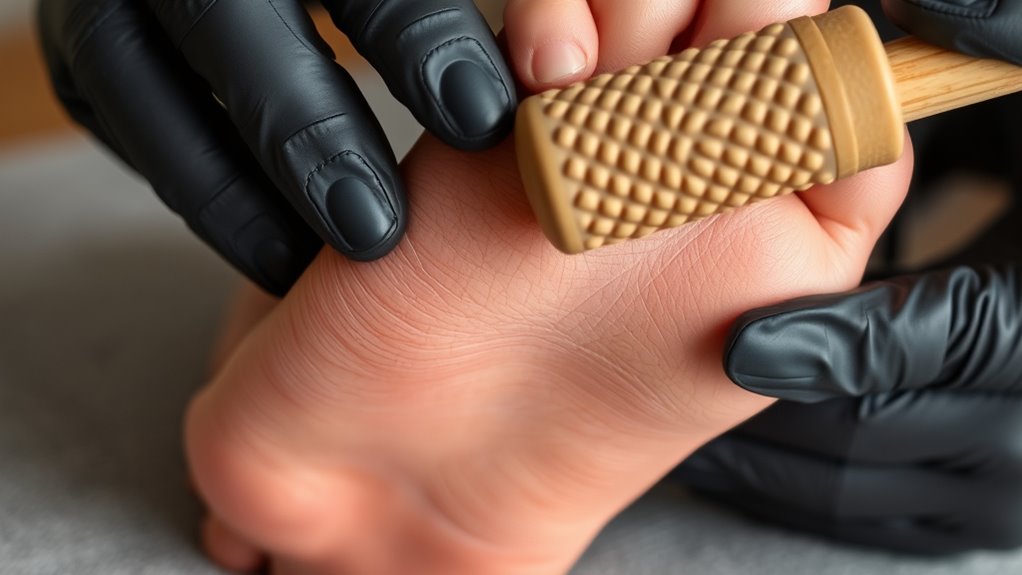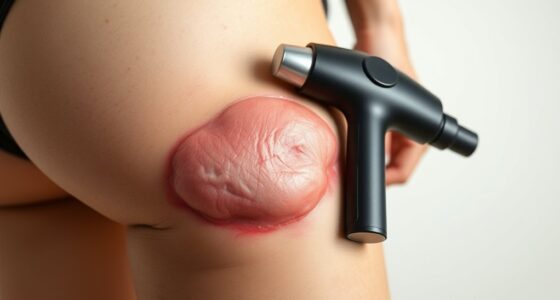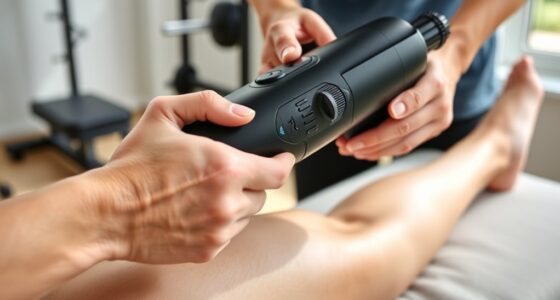To guarantee effective percussion therapy on your plantar fascia, focus on proper heel alignment and arch support. Keep your heel aligned with your ankle and avoid tilting inward or outward, which can disrupt pressure distribution. Use supportive footwear or insoles to maintain a natural arch and ensure your foot remains relaxed during treatment. Paying attention to these details helps target the fascia properly and promotes faster healing. Continue exploring ways to optimize your technique for better results.
Key Takeaways
- Ensure proper heel alignment and maintain natural arch support during percussion therapy for effective fascia targeting.
- Use gentle, controlled percussion strokes to stimulate blood flow without causing pain or discomfort.
- Keep the foot relaxed and avoid excessive force to prevent strain and enhance therapy benefits.
- Choose supportive footwear or orthotics that promote correct heel positioning and pressure distribution.
- Combine percussion with attention to foot biomechanics to optimize healing and improve overall foot health.

Have you ever considered how much your feet do for you every day? They carry you through every step, absorb shock, and keep your body balanced. Yet, many people overlook how important proper foot care is, especially when it comes to treating issues like plantar fasciitis. One effective technique involves percussion therapy on the plantar fascia, but to do it right, you need to pay attention to heel alignment and arch support. These elements are vital because they influence how your foot responds to pressure and how effectively you can target problematic areas.
Proper foot care involves heel alignment and arch support for effective plantar fasciitis treatment.
When performing percussion therapy, start by guaranteeing your heel is properly aligned. Heel alignment refers to the way your heel sits in relation to your arch and ankle. Misalignment can cause uneven distribution of pressure, making it harder to reach the fascia effectively. If your heel tilts inward or outward, it can lead to compensations in your gait and exacerbate plantar fascia pain. To correct this, consider wearing shoes that promote proper heel positioning or using orthotics designed to realign your heel. Proper heel alignment not only enhances the effectiveness of percussion therapy but also helps prevent further strain on the plantar fascia.
Next, focus on arch support. The arch of your foot acts as a natural shock absorber, and supporting it correctly is essential when working on the plantar fascia. If your arch collapses or is overly high, it can place additional tension on the fascia, making therapy less effective. Using insoles with good arch support can help distribute pressure evenly across your foot, reducing strain on specific areas. When doing percussion, ensure your foot is supported in a way that maintains its natural arch. This support allows you to target the fascia more precisely without compensating for arch-related issues. Proper arch support also minimizes discomfort during and after treatment, making your sessions more comfortable and productive.
In addition, understanding the importance of foot biomechanics can help you tailor your therapy and achieve better results. As you perform percussion therapy, remember to keep your foot relaxed and avoid excessive force. The goal is to stimulate blood flow and loosen tight fascia, not to cause pain. Combining gentle percussion with attention to heel alignment and arch support ensures you’re targeting the right areas effectively. Over time, this focused approach can alleviate pain, improve flexibility, and promote healing.
Incorporating these principles into your foot care routine makes a significant difference. When your heel is correctly aligned and your arches well-supported, you create an ideal environment for therapy to work. This not only speeds up recovery but also builds a foundation for healthier, more resilient feet. Paying attention to these details allows you to take control of your foot health, reducing discomfort and keeping you active in the long run.
Frequently Asked Questions
How Can I Tell if I Have Plantar Fascia Issues?
If you’re wondering whether you have plantar fascia issues, pay attention to heel pain and arch tenderness. You might notice a sharp or dull ache, especially in the morning or after activity. Tenderness when pressing on the arch or heel is a common sign. If these symptoms persist or worsen, it’s a good idea to see a healthcare provider for proper diagnosis and treatment options.
Are There Specific Shoes That Help Prevent Plantar Fasciitis?
Think of your shoes as a sturdy foundation for a house; they protect and support you daily. To prevent plantar fasciitis, choose supportive sneakers with good arch support and cushioned insoles. Orthotic insoles can customize that support, offering relief and stability. Wearing the right footwear acts as a safeguard, absorbing impact and reducing strain on your plantar fascia, keeping your feet healthy and strong for every step you take.
How Often Should I Perform Foot Stretching Exercises?
You should aim for a consistent exercise routine with daily stretching. For plantar fasciitis prevention and relief, perform foot stretching exercises at least twice a day—morning and evening. This stretching frequency helps maintain flexibility and reduces tension in your plantar fascia. Incorporate these stretches into your routine regularly, especially if you stand for long periods, to keep your feet healthy and prevent discomfort.
Can Footwear Modifications Alleviate Plantar Fascia Pain?
You’re hitting the nail on the head asking if footwear modifications can help with plantar fascia pain. Absolutely, they can be a game-changer. Using orthotic insoles offers arch support, while heel cushions help reduce pressure on your heel. These tweaks can make a significant difference, easing pain and improving comfort. Just remember, proper footwear can support your recovery, so don’t hesitate to give them a try and see how they work for you.
When Should I See a Doctor for Foot Pain?
When you experience persistent or severe foot pain, you should see a doctor. If your pain worsens despite rest or changes in footwear, or if you notice swelling, numbness, or difficulty walking, seek professional help. A doctor can perform diagnostic tests to determine the cause and discuss appropriate treatment options. Prompt evaluation guarantees you get the right care early, preventing further injury and relieving your discomfort quickly.
Conclusion
As you master these percussion techniques, you might find relief unexpectedly. It’s funny how a simple tap can release comfort you hadn’t realized was missing. Sometimes, the smallest adjustments make the biggest difference—like rediscovering that carefree step you thought was lost. Keep practicing with patience and confidence, because you never know when a gentle touch could turn your day around. Your feet have been waiting for this moment—trust in your journey back to pain-free walking.








